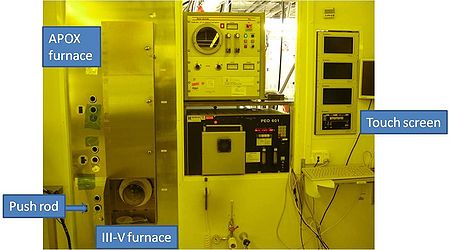Specific Process Knowledge/Thermal Process/D4 III-V Oven: Difference between revisions
Appearance
No edit summary |
No edit summary |
||
| Line 1: | Line 1: | ||
'''Feedback to this page''': '''[mailto:labadviser@danchip.dtu.dk?Subject=Feed%20back%20from%20page%20http://labadviser.danchip.dtu.dk/index.php?title=Specific_Process_Knowledge/Thermal_Process/D4_III-V_Oven click here]''' | '''Feedback to this page''': '''[mailto:labadviser@danchip.dtu.dk?Subject=Feed%20back%20from%20page%20http://labadviser.danchip.dtu.dk/index.php?title=Specific_Process_Knowledge/Thermal_Process/D4_III-V_Oven click here]''' | ||
[[Category: Equipment | | [[Category: Equipment |Thermal III-V ]] | ||
[[Category: Thermal process| | [[Category: Thermal process|III-V]] | ||
[[Category: Furnaces|III-V]] | [[Category: Furnaces|III-V]] | ||
Revision as of 14:36, 25 August 2014
Feedback to this page: click here
III-V Oven (D4)

The III-V Oven (D4) is used for wet thermal oxidation of III-V devices, for instance for lateral oxidation of thin AlGaAs layers to defined apertures in light-limiting diodes.
The furnace is an old Tempress horizontal furnace. The quartz boat is loaded manually into the furnace by use of a push rod. The furnace is cooled down to room temperature when it is not being used.
Before use, devices have to be cleaned. A short BHF dip can be used to remove any native oxide which can be difficult to penetrate by a wet thermal oxidation.
Please check the cross contamination information in LabManager before you use the furnace.
The user manual and contact information can be found in LabManager:
Process knowledge
| Purpose |
| |
|---|---|---|
| Performance | Lateral oxidation rate |
|
| Process parameter range | Process temperature |
|
| Process pressure |
| |
| Gasses on the system |
| |
| Substrates | Batch size |
|
| Substrate materials allowed |
|
